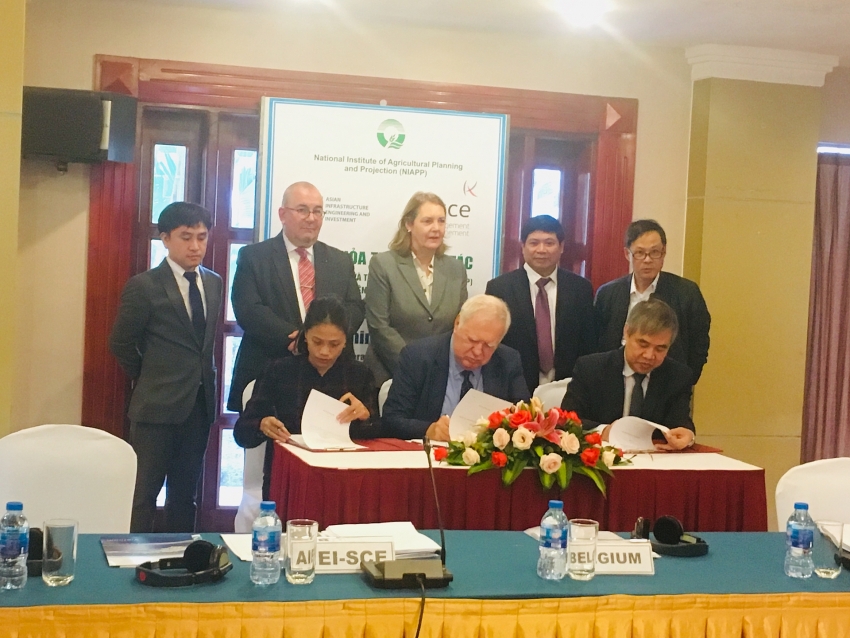Wind powered water desalination in coastal Vietnam
 |
| NIAPP and AIEI-SCE alliance will co-operate to deploy a wind powered water desalination project in the South-Central Coast and the Mekong Delta region |
Climate change is happening and it is wreaking havoc by increasing temperatures, leading to salinity intrusion and floods. According to a report of Belgium's Asian Infrastructure Engineering and Investment Company (AIEI), the total damage from salinity intrusion during the dry season and flood during the rainy season are estimated to reach 30 per cent of the total output of rice, vegetables, fruits, trees, and shrimp in 2050, equivalent to around VND3.6-12 trillion ($156.5-521.7 million).
Especially, over the last years, impoverished areas in coastal and south-central provinces have been facing salinisation, which is impacting production and life. Salinisation has entered about 35-40 kilometres into the Mekong River Delta, with the salinity level at around 14.6-31.2 grammes per litre, and especially, the Tien River has been salinised 90km inwards from the coast.
These measurements come from the Ministry of Agriculture and Rural Development's National Institute of Agricultural Planning and Projection (NIAPP) and were disseminated at the Workshop on Drought, Salinity Intrusion and the Application of Wind Power Water Desalination Technology in the South Central Coast and Mekong Delta Regions yesterday morning (December 18, 2018).
At the workshop, Nguyen Quang Dung, director of NIAPP, said that water shortage and salinity intrusion in these regions are extremely serious both in scale and duration. Salinity intrusion usually happens during the dry season, when saline water invades 7km into the land in Ninh Thuan, Binh Thuan, and 20km in Soc Trang, Ben Tre, Bac Lieu, and Kien Giang provinces.
In Bac Lieu and Ca Mau, both locations suffering from high saline intrusion (at 20g per litre), which causes a lack of clean water for life and production, as well as decreases productivity and the output of rice and fruits.
According to a research conducted by AIEI in Ninh Thuan, the heaviest salinity intrusion lasts from March to September every year, and affects coastal delta areas, such as Ninh Hai, Ninh Phuoc, Thuan Nam, and Phan Rang-Thap Cham city.
People living in areas with water scarcity and saline intrusion use underground water for irrigation and for use in daily life. If there is no underground water, people have to buy clean water and change the crop structure.
A representative of AIEI said that over the last five years, droughts in Ninh Thuan have caused a lack of water for 15,000-20,000 households, as well as more than 5,000ha of rice plantations. Damage in the agricultural sector is estimated at hundreds of billions of dongs.
As a result, the joint venture between Belgium's AIEI and France's SCE has developed a wind powered water desalination technology in Ninh Thuan. The joint venture will develop five pilot systems run by green energy in Ninh Thuan, Binh Thuan, Soc Trang, Ca Mau, Kien Giang, and Ben Tre to provide water irrigating for the daily lives of 10,000-20,000 people and for around 40ha of rice cultivation area per day. The capacity of each system is estimated at 400 cubic metres per day.
What the stars mean:
★ Poor ★ ★ Promising ★★★ Good ★★★★ Very good ★★★★★ Exceptional
Related Contents
Latest News
More News
- PM orders investment model for North–South high-speed rail (December 22, 2025 | 17:43)
- First members of Danang International Finance Centre revealed (December 22, 2025 | 17:39)
- Securing capital and efficiency for Vietnam’s 2026-2030 growth ambitions (December 17, 2025 | 10:00)
- Driving double-digit growth through green and circular transformation in Vietnam (December 17, 2025 | 09:00)
- Vietnam bucking trend in the global M&A landscape (December 16, 2025 | 14:20)
- Vietnam’s green transition demands collective financial action (December 15, 2025 | 12:00)
- VIR workshop highlights capital and policy for sustainable development (December 15, 2025 | 11:00)
- National Assembly approves pilot mechanisms to accelerate major projects in Hanoi (December 12, 2025 | 11:29)
- Vietnam eases policy approval requirements, simplifies foreign and outbound investments (December 11, 2025 | 17:53)
- Unpacking new momentum in Vietnam’s M&A market (December 10, 2025 | 09:59)

 Tag:
Tag:



























 Mobile Version
Mobile Version